Badgers - Nature’s JCBs

Now a fully protected species in the UK, emotions are once again running high as the Government's concern over the spread of bovine TB results in regional culls.
But, what exactly does Mr Badger get up to as he goes about his daily life?
Badgers are nocturnal, powerful, social animals. They live much of their lives below ground in family groups and, sadly, the only time many people see them is as carcasses on the roads; victims of today's high-speed and increasingly busy traffic. Anyone lucky enough to watch them in the wild as they emerge, groom, feed and interact will understand why these iconic animals hold such a place in the nation's affections.
Badgers are supreme diggers, and it seems likely that their name is derived from 'becheur', the French for digger. In the wild, they live for five to seven years, though some survive until they reach twelve or thirteen. Females are called sows, males are known as boars. The young are cubs.
Body weight of adult badgers varies with the season, the area in which they live, the amount of food available and their age. Badgers are at their heaviest in late autumn as they fatten up for winter. They then feed less, spend more time inactive underground and, subsequently, their weight falls away. Sows are at their lightest after giving birth.
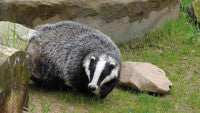
Other than the genitalia, normally visible only when badgers sit up to scratch or lie back, there are no obvious, utterly reliable visual differences between the sexes. Many experienced badger watchers admit that they have often failed to correctly identify boars from sows, and it's not until, for example, a boar starts to suckle cubs in full view that "he" becomes a "she"!
How many badgers are there?
Based on the most recent national survey of badger setts, carried out in 1997, which assumed an average of six to each main (breeding) sett, the UK's badger population is put at around 300,000. Defra is shortly to produce a report with updated estimates. Claims of an explosion in badger numbers can be discounted.
Sense and sensibility
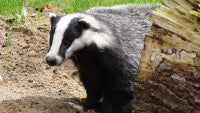
The badger's world is dominated by scents and sounds. It's not surprising that an animal with relatively small eyes, which spends most of its life underground in the darkness of tunnels and chambers, has unexceptional vision.
There is some dispute about just how well badgers can see. Experienced badger watchers will confirm that badgers often approach within a few metres of someone who is well hidden and sitting downwind. Conversely, they appear to be able to pick up new or different silhouettes from twenty metres away in poor light.
Watch a badger feeding and it's apparent that smell rather than sight is the key to finding inert food, and there is good evidence that sounds inaudible to us - for example the rustle of an insect under moss or leaves, or the slither of an earthworm moving across damp grass - help them locate live food.
Unusual sounds - like the snap of a twig, the rustle of clothing, or a human voice in the quiet of a wood - alert and alarm badgers, whilst commonly heard sounds of passing traffic, dogs barking or planes overhead are usually ignored.
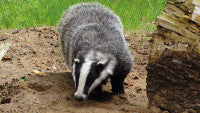
Experimental work suggests a sense of smell 800 times more acute than humans, and there are numerous reports of badgers following the same line of scent trails even when, days or weeks earlier, the trails have been ploughed in and apparently destroyed.
Damp, humid conditions hold scents more readily than dry, arid days and the badger's ability to distinguish a familiar human scent from one that's unfamiliar is well demonstrated when strangers first join a badger-watching group and are greeted with alarm or an unusual degree of caution.
The ability to recognise, by smell, individual members of the same social group is vital to badgers as, for the most part, they reject - and often fight fiercely with - badgers of the same sex from different social groups. This sensory identification is achieved by musking. A pale yellow, fatty substance released from sub-caudal glands just below the tail is used to mark other badgers in the same social group.

Badgers also have anal glands which discharge a yellowish-brown substance with a rank smell and it appears likely that this liquid gives faeces a smell which other members of the same group recognise.
Well bred
Badgers mate at almost any time of the year but, thanks to an unusual reproductive technique known as delayed implantation, they have only one litter a year. Litter size ranges from one to five cubs, with two or three the more common. Cubs are born in chambers lined with any available suitable bedding material that the sows can gather and drag into the breeding chamber. Straw, hay, grass and fern are all commonly used, along with a wide range of green plants which heat up and give off warmth. In the Midlands and the south of England, most cubs are born in early to mid February, and cubs from those litters emerge above ground for the first time in early to mid April. Further north the timing is likely to be a little later.

But, as ever in nature, there are lots of exceptions. Rarely, cubs are born as early as December, others as late as March. The reasons for such variations are unclear, but the health, age and fitness of the sow, and an instinctive response to severe or exceptionally mild weather conditions, are likely factors that delay or bring forward birth times.
Pink-skinned, about 120mm long, covered in greyish-white silky fur, with eyes sealed for the first few weeks, new-born cubs range in size from around 75g to 130g. Suckled underground, they put on weight quickly, body hair starts to grow and, by the time they emerge above ground for the first time (often rather unsteady on their feet), they have the distinctive striped face that makes badgers so recognisable. Cubs are usually fully weaned at around fifteen weeks.
Badger setts
Setts vary from single-entrance, short-tunnelled, occasionally used 'outliers' to vast, ancient, sprawling underground complexes with multiple entrances extending to 100 metres or more. These are the family homes, used, maintained, and enlarged at will by generations of the same social group.
Badgers have shaped much of our landscape. Large, odd-looking humps and bumps in woods, hedgerows, fields and hillsides are often the work of badgers - nature's mini JCBs. They love to dig and they are very good at it. Main breeding setts - some centuries old - are made up of a myriad of mostly interconnecting tunnels and chambers, often at two or three different levels.
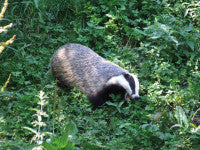
Main setts can hold any number of badgers, from the more usual five or six to as many as twenty in the larger complexes. Main setts often change in size and shape as badgers dig new tunnels and chambers. This year's busy entrance with soil worn smooth by the passage of many paws can be next year's cobweb-covered or debris-blocked disused entrance. Why, we can't be sure, but badgers do die underground and it is likely that the rest of the clan move elsewhere in the sett. When the social group increases in size following successful breeding seasons, more tunnels and chambers - our equivalent of house extensions - are needed. In addition, tunnels collapse, banks give way and trees crash, taking protective root systems with them. So badgers have to constantly adapt. It may also be the case that they simply instinctively enjoy digging and like the freshness of newly-dug living quarters.
Badgers thrive in hilly, well drained areas with plenty of short-cropped pasture and broad-leaved woods. They do less well where the ground is relatively barren and stony and in the middle of large woods where close-growing conifers dominate. The richer the soil the better the foraging.

Subsidiary setts are normally a little further from the main setts, may have several entrances, but generally lack connecting paths to other setts.
Outliers are usually single hole setts with a short length of tunnel and appear to be occasionally used, perhaps as a bolthole, a temporary resting or sleeping place, or even as a source of food - a place to find worms and insects.
Disused setts, both rural and urban, often provide foxes with a ready-made den in which they will raise their young, and foxes will also set up home in an inactive part of a large sett. There are reports of foxes venturing into active setts and snatching badger cubs and, equally, accounts of fox cubs ending their days in the jaws of badgers underground.
Sightings of other squatters in badger setts include polecat, rabbits, hedgehogs (not a wise place for them to be), mice (woodmice especially), rats and feral cats.
Paths
Badgers are creatures of habit. They regularly visit the same patches of woodland or open pasture to forage for food and, to do so, they follow the same musk-scented trails which they and generations of badgers before them have created. Paths leading from large setts are often grassless tracts of shiny mud worn smooth by the constant passage of broad, powerful feet. The further away from setts, the less obvious the pathways become, for by this point badgers from the same social group will have headed in different directions to feed, often alone rather than in groups.
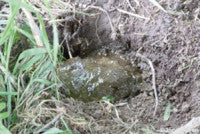
Badgers usually defecate in dung pits; self-dug shallow holes, a few centimetres deep. The dung is typically loose, smooth and watery, but the consistency and colour varies depending on the type of food being eaten.
Latrines are a collection of dung pits, often spread over several square metres of ground under bushes and other foliage. It has long been thought that they act as territorial boundary markers - indicators to badgers from other social groups that they are 'trespassing'. But, more recently, that singular conclusion has been challenged and it may be that they also provide information. Sows, for example, might wish to indicate their presence (or availability) to males from other social groups, and, likewise, boars might wish to alert sows to their presence.
Whatever the significance of these dung pits on the edge of territories, they are also commonly found where badgers feed regularly, and close to main setts. Small quantities of faeces deposited on the surface without any attempt at an excavation are frequently a sign that cubs are about. Corners of fields, hedgerows with well worn tracks leading into them or through them, the edge of woods, especially beneath or close to young elder trees and under blackberry bushes, are all frequent latrine sites.
The contents of latrines give a clue to the food being eaten. Peanuts, fed to badgers in gardens or at setts, often pass through the digestive system whole and appear in the faeces, as do, for example, the red berries of yew trees, a popular autumnal food. If the faeces are watery, that is an indicator that worms are in plentiful supply. Closer examination of the faeces provides more clues - the bones of tiny rodents, strands of hair from young rabbits, the husks of cereals, the wing cases of beetles, and so on.
Pale yellow secretions of musk may be evident in latrines, especially where they appear to be territorial markers.

Usually close to sett entrances, badgers, young and old, often rear on to their hind legs, reach out and scratch the bark of a tree, commonly elder. The vertical marks they leave in the bark are easy to see and frequently extend to near ground level. Some observers describe the action as claw sharpening. Others, say it is simply a stretching exercise after hours spent underground. Many regard it simply as a way to clean claws coated with mud. Yet another explanation is that tree-scratching is a territorial marker.
Snuffle holes
As they hunt for grubs, insects, beetles and, notably, earthworms, badgers leave behind them lots of visual evidence. They will claw out pieces of turf, create shallow circular snuffle holes (as they push their nose into soft soil), turn stones over, remove chunks of rotting timber from fallen trees and dig out large holes to reach bee and wasp nests.
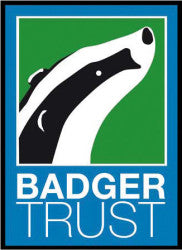
Your county wildlife trust or local badger watch will be able to offer further advice. Alternatively, contact Badger Trust at www.badger.org.uk
Why are badgers protected?
Badgers and their setts are legally protected from intentional cruelty, such as badger-baiting, and from the results of lawful human activities, such as building developments. The legislation, mainly the Protection of Badgers Act 1992, has provided a useful tool in deterring the abuse of badgers and in prosecuting those who continue to break the law.
However, it is a sad fact that many thousands of badgers are still killed illegally each year, and the incidents appear to be increasing. Also, due to the nature of the crimes, there are relatively few successful prosecutions.
These notes are intended to provide some background to the law relating to badgers. However, the issue is complex and more detailed information can be obtained by contacting Badger Trust www.badger.org.uk.
Threats to badgers
Badgers in the UK are threatened by both legal and illegal activities.
Legal activities, subject to compliance with conditions in the 1992 Act, include:
- road and housing development
- leisure, forestry and agricultural operations
- culling by the Department of Environment Food and Rural Affairs and the Welsh Assembly Government in relation to bovine TB in cattle
Illegal threats to badgers include:
- digging and baiting
- snaring
- poisoning (including the misuse of pesticides)
- lamping and sett interference
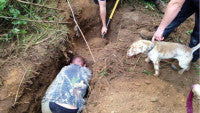
The main legislation protecting badgers in England and Wales is the Protection of Badgers Act 1992 (the 1992 Act). Under the 1992 Act it is an offence to:
- wilfully kill, injure, take or attempt to kill, injure or take a badger
- possess a dead badger or any part of a badger
- cruelly ill-treat a badger
- use badger tongs in the course of killing, taking or attempting to kill a badger
- dig for a badger
- sell or offer for sale or control any live badger
- mark, tag or ring a badger; and interfere with a badger sett by:
damaging a sett or any part thereof
destroying a sett
obstructing access to a sett
causing a dog to enter a sett
disturbing a badger whilst occupying a sett
The 1992 Act defines a badger sett as: "any structure or place which displays signs indicating current use by a badger".
The 1992 Act: powers of sentence
(i) up to six months imprisonment or a fine at level 5 or both. The fine may be multiplied by the number of badgers
(ii) forfeiture of any badger or skin relating to the offence or any weapon or article used
(iii) order destruction or disposal of dogs
(iv) disqualification for having custody of a dog
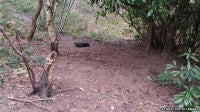
There have been various amendments to the 1992 Act, most significantly through the Hunting Act 2004 and the Environment and Rural Communities Act 2006.
Provided certain conditions were met, sections 8(4) to (9) of the 1992 Act used to permit fox hunts to obstruct the entrances of badger setts to prevent foxes seeking refuge and allowed hounds to mark at a badger sett. The Hunting Act 2004, which came into force on 18th February 2005, repealed sections 8(4) to (9) of the 1992 Act.
The Environment and Rural Communities Act 2006 extends the power of Wildlife Inspectors to the 1992 Act. It extends a police officer's search warrant power to the 1992 Act. It also extends the time limit to six months, within which proceedings in England and Wales for a summary offence under the 1992 Act can be brought, beginning with the date on which sufficient evidence in the opinion of the prosecutor to warrant the proceedings came to his knowledge.
Scotland
Since 2004, badgers in Scotland have been protected by the Protection of Badgers Act 1992 as amended by the Nature Conservation (Scotland) Act 2004.
Other legislation
Badgers are also listed in Schedule 6 of the Wildlife and Countryside Act 1981 and section 11 of this Act prohibits the use of certain methods of taking or killing a wild animal, including illuminating devices and some snares.

The sentence under these Acts is a fine at level 5 or imprisonment up to six months; confiscation or destruction of dogs and a ban on keeping animals.
The Powers of Criminal Courts Act 1973 (section 43) allows the forfeiture of property used, or intended to be used, to commit or facilitate the commission of any offence, including dogs.
There are powers of arrest only for cruelty to, or abandonment of, domestic or captive animals under the 1911 Animals Act, or if the general arrest conditions apply (section 25 of PACE, 1984).
The Control of Pesticides Regulations 1986 prohibit the use of unapproved products to deter or kill animals, including badgers. There are no chemical repellents licensed to be used specifically to deter badgers, since approval for Renardine was withdrawn on 24th March 2005.
Licensing: development and protection of property
The Protection of Badgers Act 1992 allows for licences to be issued for a number of purposes, including development under the Town and Country Planning Act 1990 and to prevent serious damage to property.
Licences to interfere with badger setts or disturb badgers for development, or to prevent serious damage to property (including land, crops and poultry) are issued by the Government's statutory nature conservation agencies (Natural England, Countryside Council for Wales or Scottish Natural Heritage). Such licences can allow the interference with, and/or closure of setts. In some cases, licences are issued to allow the killing of badgers, although this is generally a last resort and only a handful of such licences are issued each year.
Licences may be granted by the conservation agencies for interference with badger setts in the course of investigating offences. Such licences are normally issued to Police Wildlife Crime Officers and to others officially involved in this work.
Other purposes for which licences may be granted are science, education and conservation; zoos; tagging and marking; archaeology; disease prevention; agriculture and forestry; land drainage; and controlling foxes for the protection of livestock, game and wildlife.
Licensing bodies
Natural England: Tel: 0845 600 3078
Countryside Council for Wales /Cygnor Cefn Gwlad Cymru: Tel: 0845 1306229
Scottish Natural Heritage: Tel: 01463 725000
DEFRA (Wildlife Management Team): Tel: 0117 372 8003
NAWAD (Food Farming Development Division): Tel: 01970 613295
Scottish Environment & Rural Affairs Department: Tel: 0300 244 4000
Badger Trust was PAW Partner of the Year 2005
www.defra.gov.uk/paw
